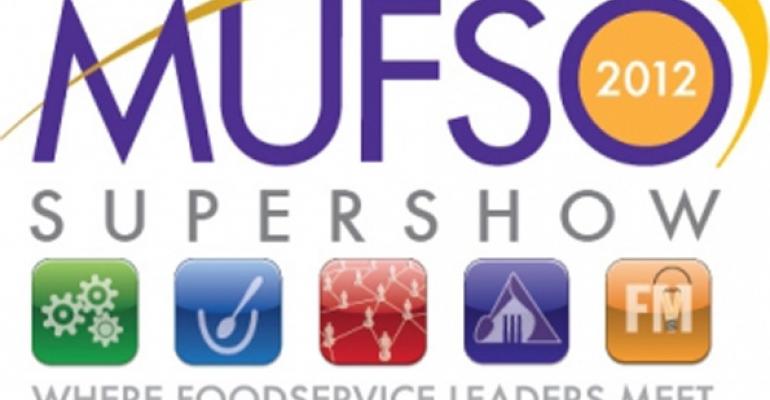This is part of Nation Restaurant News' special coverage of the 2012 MUFSO conference, taking place Sept. 30-Oct. 2 at the Hilton Anatole Hotel in Dallas. Follow coverage of the event on NRN.com's ‘At the Show’ section, read onsite blogs from NRN editors at Reporter’s Notebook, and Tweet with us using #MUFSO.
Marketing expert and keynote speaker Scott Stratten told MUFSO attendees Tuesday that they must go above and beyond the competition to engage with customers in today’s crowded marketplace.
“You must be awesome," Stratten said. “Anyone can be cool, but awesome takes practice.”
He added that when it comes to social media or viral marketing, people tend to share "awesome" experiences. “We spread stories, we spread our experiences,” he continued. “I firmly believe that loyalty is not built on the cards you bring into restaurants. I think loyalty is built on experiences and how we can foster those things.”
Stratten cited as an example the story of a family that vacationed at a Ritz-Carlton resort. When the family returned home, they discovered their child had lost his stuffed giraffe, Joshie. The father consoled the child by telling him that Joshie was still back at the hotel taking an extended vacation, but he called the hotel in a panic, hoping the staff had found it — and they had.
RELATED
• Nontraditional competitors threaten restaurant market share
• Industry leaders talk menu labeling, economy at MUFSO
• More MUFSO coverage
“Typically, a hotel would mail it to you and you’d get it in six to eight months,” Stratten said. “But not only does the Ritz-Carlton not charge them to send it back, but they overnighted it. And to perpetuate the story that Joshie had been on an extended vacation, the hotel took photos of Joshie catching rays by the pool, hanging out by the bar with new friends, playing a round of golf, and sent them along. They staged these shots to help the dad out and make the kid feel special.
“So what did the father do? He blogged about it, e-mailed about it, tweeted about it, Facebooked about it. He told the world. Now, when you see a Ritz-Carlton logo, what do you think? You think awesome.”
Awesome also can have a direct return on investment, Stratten continued. During a stay at different hotel, he said he phoned down to the front desk for a wake-up call at 7:30 the next morning. The employee at the desk, after taking the information and observing solicitously that it sounded very early, wondered whether he might like to have a pot of coffee sent up to his room following the wakeup call. He answered yes.
When the coffee arrived, Stratten said he was more than happy to pay for the pot — despite the fact that it was overpriced — noting: “She probably paid her day’s wages in 45 seconds just for suggesting the coffee. Being awesome has ROI. Passion and knowledge equals profit.”
Using technology with caution
At the same time, Stratten cautioned attendees against getting caught up in the latest marketing craze, and pointed to QR codes as an example of technology that often is being employed haphazardly. “We are misusing them. I’ve seen QR codes on billboards by the side of the highway — where we can’t scan them. I’ve seen QR codes in the subways in Toronto — where you can’t get a signal underground," he said. “About 80 percent of QR codes don’t function properly. It doesn’t make any sense.”
Stratten also warned attendees about being careful when it comes to using social media. “I don’t think everybody should be using social media,” he said. “And, frankly, I don’t think most executives and CEOs should be on Twitter. I don’t think an unfiltered access to the world is a smart thing for people who are used to having layers of PR people.”
In addition, he said, social media “doesn’t fix anything. It just amplifies things. If your restaurant sucks, it just sucks harder in social media. It doesn’t make your chicken fingers taste better or your beer taste bolder. Social media is not a good place to go if you’re terrible at what you do.”
Nevertheless, he added, whether a restaurateur uses it or not, it doesn’t really matter; social media remains part of today’s marketing landscape, where everything is shared and spread.
“Consumers have been beaten down forever,” he said. “They had no recourse [to complain]. It was not a level playing field. Now, when we’re angry, we can [use social media] to fight back.”
He recounted a story about how a server in a Papa John’s outlet in New York used a racial slur to describe a woman on a check, which the customer then saw. The woman responded angrily that her name was not “Lady Chinky Eyes,” photographed the check and then blogged it. The message went viral and was seen by hundreds of thousands of people. “The power of it can be incredible,” Stratten said.
But stories like that also can turn out favorably for a restaurant. Stratten related another story about a different pizza chain that requested customers e-mail comments or questions pertaining to its business. One customer replied by suggesting that the chain offer a picture of a unicorn fighting a bear on their pizza boxes.
The message was received at the chain’s call center. “Unfortunately, our stores are not equipped to fulfill such a request,” one of the chain’s employees responded. “They don’t have the required skills. I, however, took it upon myself to draw the picture you requested on a Post-it note. I hope this suits your needs.”
The Austin’s employee’s drawing of the unicorn and the bear was viewed 7.5 million times. “That’s awesome,” Stratten said.
This keynote address was sponsored by e*Restaurant from Altametrics. Find more MUFSO 2012 coverage online at NRN's sister publications, Restaurant Hospitality and Food Management.
Contact Paul Frumkin at [email protected].
Follow him on Twitter: @NRNPaul





